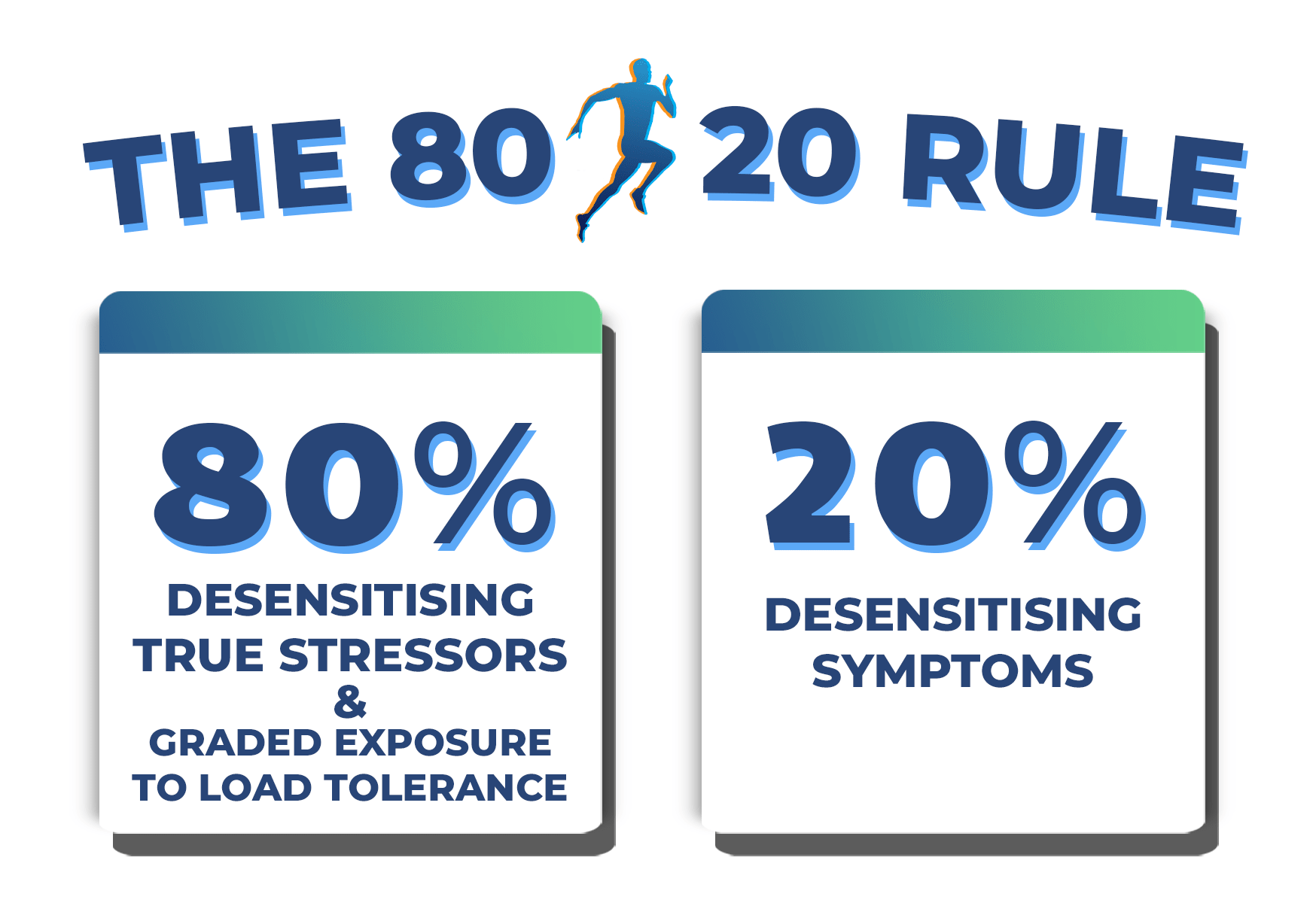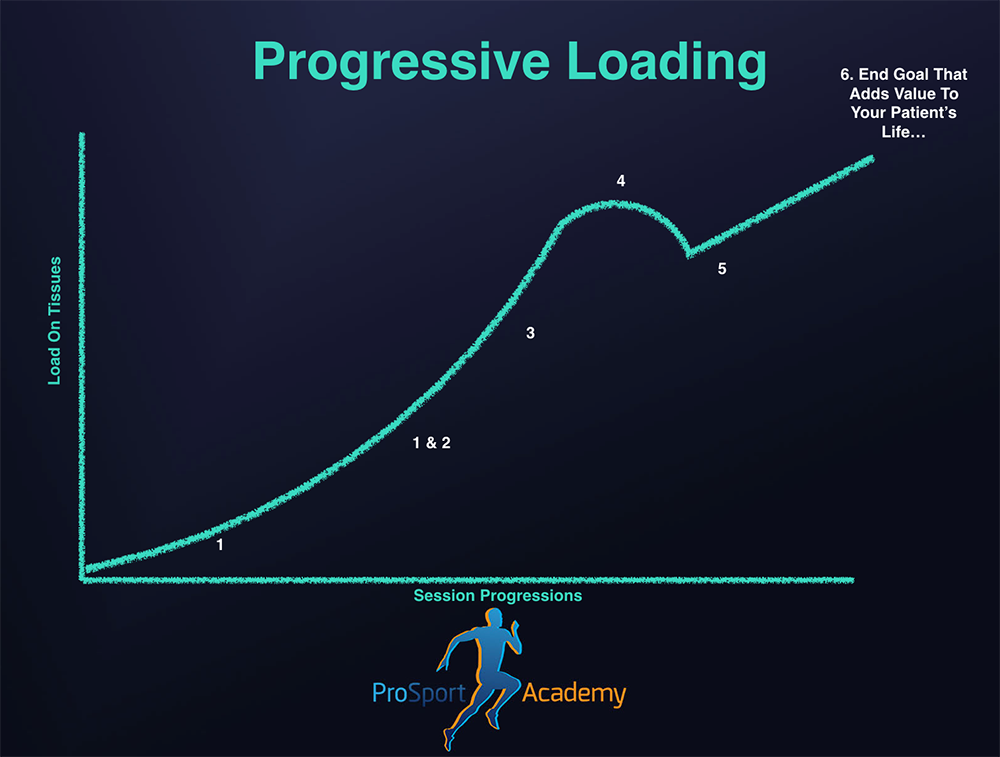The 80/20 Rule Of Physical Therapy & Designing An Effective Treatment Plan
In pillar 3 of the Go-To Therapist pillar system, we explained how effective explanation is key to complete patient ‘buy-in’ & adherence to every exercise. But patient ‘buy-in’ isn’t important if you don’t have a treatment plan.
By this point, after making sense of your patient’s story in the subjective assessment and objective assessment stages you should have your 80/20 treatment plan ready to go.
20% of your time (6 minutes in a 30-minute session, 12 minutes in an hour session) is given to desensitising the tissues contributing directly to the pain experience.
This can include your eccentrics, isometrics; whatever you need to do to settle the pain experience.
80% of your time (24 minutes out of 30 or 48 minutes out of a 60-minute session) are given to WHY these tissues have overloaded or become sensitised in the first place.
LOADING AND SPEED OF LOADING
At this point, it is important to note that muscles will be able to produce different amounts of force at different speeds as well as different lengths.
Therefore, the speed of the movement and the ability to coordinate this is extremely important to consider when preparing your patient for returning to their activities.
The ‘Go-To’ Therapist has 4 key sections that they want their patient to be comfortable with:
- Low Load / Low Speed
- Low Load / Higher Speed
- High Load / Lower Speed
- High Load / High Speed
Examples of low load / low speed would be the coordinative testing performed on the bed and low level isometrics.
Examples of low load / high speeds would be an ‘elastic’ lunge in a specific direction.
Examples of high load / low speed would be lifting a kettlebell from the floor in a split stance position with a relaxed back.
Examples of high load / high speed would be hopping progressions, decelerations and sprinting.
You can instantly progress an exercise from low speed to high speed by obviously increasing the speed of the movement; you may then see a completely different movement strategy and this is why it’s important to expose your patient to all of these sections in the graded exposure.
A key goal for all our patients is the ability to perform the movements relaxed, both with low and high speed.
It is a far greater challenge to RELAX than it is to TENSE or CONTRACT. Therefore, if a big goal of our rehab plan is to restore coordination and movement efficiency in a specific direction, then performing movements relaxed regardless of load and speed is of utmost importance. This is why I love the phrase ‘thoughtless, fearless movement’.
Now let’s take you through a clinical scenario of a patient with osteitis pubis who has right-sided groin pain but has a decreased motor output through the same side lateral hip on assessment with a bad previous ATFL injury to the same side ankle.
20% of my time will be focused on desensitising the adductor tissues and 80% on restoring the ability to tolerate load through the peroneal and lateral hip tissues. In later pillars, I’ll share with you exactly how I’ll achieve this.
But first remember, this is just one scenario and you may actually need to look at the opposite leg if your assessment findings take you there.
So the bird’s eye view for this treatment plan would be as follows:
Session 1: 20%: Desensitise adductor tissues, reduce pain provocation tests, restore full hip abduction passive length and whatever other reactions were found in the assessment | 80%: Restore motor output through the peroneals and posterior lateral hip at 40% MVC on bed and give isometric equivalent as home exercise programme +/- standing variation.
Session 2: 20%: Recheck hip abduction and pain provocation tests and repeat if required. | 80%: Recheck 40% MVC in each direction on bed, restore if required with hands-on treatment. Progress to standing lower load with higher speed loading.
Session 3: 20%: Asymptomatic with full range or repeat session. | 80% Progress to higher loading with lower speeds.
Session 4: 20%: Asymptomatic. | 80%: Progress to higher loading and higher speed progressions.
Session 5: 20%: Recheck for any adaptations after higher loading and desensitise if required. | 80%: Progress to field deceleration drills, biasing the direction as required.
Session 6: 20%: Recheck for any adaptations after higher loading and desensitise if required. | 80%: Progress to field deceleration drills approx. 90%, biasing the direction as required.
Session 7: 20%: Recheck for any adaptations after higher loading and desensitise if required. | 80%: Progress to final deceleration and acceleration drills, biasing the direction as required at 100% with thoughtless, fearless movement. Plan to discharge with correct graded exposure based movement warm up in place.
Notice in sessions 1 and 2 how the hands-on treatment was the first step in the graded exposure and by sessions 3-6, there is minimal hands-on treatment, just more reassurance and then it’s straight onto the graded exposure.
If you are finding you need to do more and more hands-on treatment as the sessions progress, then I would be concerned that we have not found the true stressors yet and there are considerable adaptations present still.
A big challenge for therapists initially when they come on my mentorship is when to progress a patient or when the patient is ready to run.
The beauty of this way of progressing a patient is we do it through a graded exposure so by the time they’ve done session 4, we’ve exposed them to not only similar loads but also greater loads through the tissues that previously had a perceived threat, using techniques that we will cover in pillar 5.
So using some of these simple tweaks, we can bias certain tissues in a controlled environment with ground reaction forces and rates of force development that are actually greater than they need to tolerate when running, for example.
So, for example, if we have a patient that performed our high level hopping progression in session 4 with no reaction in session 5 with regards to decreased range of motion, swelling or whatever KPIs we were using, we can be pretty confident now that the patient can tolerate the loading required for running.
You have now logically justified to yourself that the patient has earned the right to progress without second guessing or making emotional decisions. This is very powerful and will give you amazing confidence and clarity; by this stage your patient will also be feeling very confident.
Learn more about designing treatment plans with Karl Morris and his cockpit analogy in ‘How To Design Great Treatment Plans Using The Cockpit Analogy’
Once you are comfortable with the 80/20 and designing an effective treatment plan, you can move on to pillar 5, your hands-on treatment and the start of the graded exposure.





